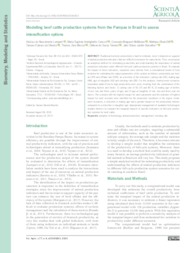Modelling beef cattle production systems from the Pampas in Brazil to assess intensification options.
Modelling beef cattle production systems from the Pampas in Brazil to assess intensification options.
Autoria: LAMPERT, V. do N.; ANDRIGHETTO CANOZZI, M. E.; MCMANUS, C. M.; DILL, M. D.; OLIVEIRA, T. E. de; MERCIO, T. Z.; TEIXEIRA, O. de S.; BARCELLOS, J. O. J.
Resumo: Traditional livestock productivity is hard to estimate, since it depends on a gamut of animal production indicators that are difficult to measure for many farms. Thus, we propose an analytical method for estimating productivity and understanding the importance of animal production indicators under different full-cycle cattle production systems in Brazil. To evaluate the impact of these indicators, equations were derived from a comutational model of herd evolution for estimating the output parameters of the system as follows: productivity per hectare (PH) and offtake rate (COR), as a function of the indicators; calving rate (CR), mating age (AM), age of slaughter (AS) and stocking rate (SR). For this analysis, twenty-seven scenarios (simulation data) of low to high productivity were used, resulting from the combination of the following factors and levels: 1) calving rate of 50, 65 and 80 %; 2) mating age of heifers of one, two and three, years of age; and 3) age at slaughter of one, two and three year old steers. The scenario with the highest impact for each parameter and the indicator of highest impact for each scenario were identified for the production conditions in the region. Under most scenarios, a reduction in mating age had a greater impact on the productivity indexes compared to a reduction in slaughter age. Appropriate management of available technologies enables farmers to compare the marginal impacts of specific indicators on full-cycle production systems for beef cattle. Keywords: adoption of technology, animal production, management, stocking rate
Ano de publicação: 2020
Tipo de publicação: Artigo de periódico
Unidade: Embrapa Pecuária Sul
Palavras-chave: Gado de Corte, Produção Animal
Observações
1 - Por padrão são exibidas publicações dos últimos 20 anos. Para encontrar publicações mais antigas, configure o filtro ano de publicação, colocando o ano a partir do qual você deseja encontrar publicações. O filtro está na coluna da esquerda na busca acima.
2 - Para ler algumas publicações da Embrapa (apenas as que estão em formato ePub), é necessário ter, no celular ou computador, um desses softwares gratuitos. Sistemas Android: Google Play Livros; IOS: iBooks; Windows e Linux: software Calibre.
Acesse outras publicações
Acesse a Base de Dados da Pesquisa Agropecuária (BDPA) para consultar o acervo completo das bibliotecas da Embrapa.

